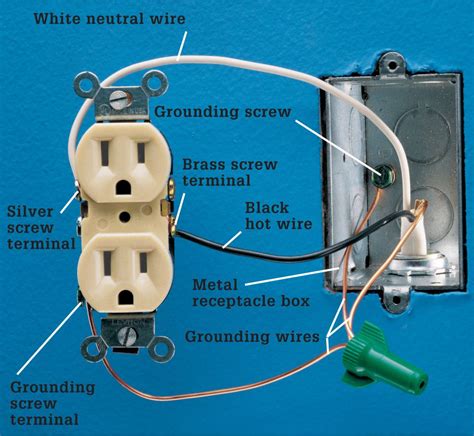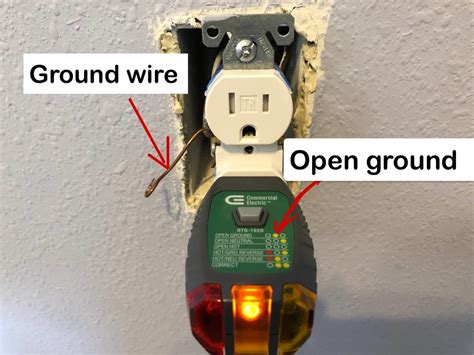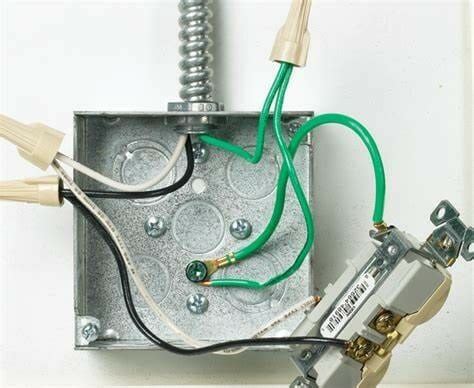can you ground outlet to metal box Don't ground to the electrical box. Connecting the ground wire to a metal electrical box will energize the box in the event of a short circuit. The box could overheat and start a fire, or someone could get a shock from touching it. . $40.00
0 · wiring a receptacle metal box
1 · proper grounding of an outlet
2 · pigtail ground to metal box
3 · outlet grounding pigtail type
4 · grounding screw for metal box
5 · grounding a receptacle metal box
6 · ground wire touching metal box
7 · ground clips for receptacle box
If you are really looking at up to 10 machines, it makes a whole lot of sense to look at alternatives that may take less spindles and less man power. Support is important but how much support you need is also a critical factor in choosing the machines.
wiring a receptacle metal box
metal fabrication vs welding
proper grounding of an outlet
Pay close attention - if the ears "bottom out" on the metal of the box, you do not need that ground wire. If they bottom-out against drywall, you need a ground. Unrelated, one more tip on the device-mounting screws.Only metal boxes need to be grounded. However, the grounding wires in a plastic outlet or switch box should not be cut back so short that they are challenging to work with. You must allow . If you have a grounded conduit going in to a metal box (no ground wires), do you need to attach a grounding pigtail to the metal box and then to the outlet ground screw? Or is .
If your receptacle has only two prongs, use a multimeter by placing one lead in the hot port on the receptacle and the other on the metal outlet box or the metal of the plate screw. If the meter reads around 120 V, then the box is . Don't ground to the electrical box. Connecting the ground wire to a metal electrical box will energize the box in the event of a short circuit. The box could overheat and start a fire, or someone could get a shock from touching it. . Grounding to a Metal Box. In some cases, if the outlet box is metal and properly connected to the ground, you can ground the outlet to the box. Here’s what to do: Verify that the metal box is grounded. Install a grounding .

The grounding means might be a grounded metal box, or a bare or green copper equipment grounding wire in the box. With some basic testing, you should be able to determine if a grounding means exists. Non-Grounding .It would be very easy to piggy back a ground from the outlet plug to somewhere on the metal frame of the box. Its safer and just means you won't get a shock if bare wires touch the metal box.
metal fabrication utility cargo jacket
If the junction box holding the receptacle is metal instead of plastic, you need to ground the incoming wire to this as well. To do this, you'll need to attach the incoming ground wire to the box's ground screw with the . You don't need a wire to ground the switch, the mounting screws satisfy the requirement when used with metal boxes, and there is an exception that allows you to not satisfy grounding requirements if no grounding means exists for replacement switches. Pay close attention - if the ears "bottom out" on the metal of the box, you do not need that ground wire. If they bottom-out against drywall, you need a ground. Unrelated, one more tip on the device-mounting screws.Only metal boxes need to be grounded. However, the grounding wires in a plastic outlet or switch box should not be cut back so short that they are challenging to work with. You must allow enough slack so that all wires in an electrical box are at least six inches (150mm) long (Article 300.14).

If you have a grounded conduit going in to a metal box (no ground wires), do you need to attach a grounding pigtail to the metal box and then to the outlet ground screw? Or is the metal/metal/outlet screws connection enough to provide grounding? If your receptacle has only two prongs, use a multimeter by placing one lead in the hot port on the receptacle and the other on the metal outlet box or the metal of the plate screw. If the meter reads around 120 V, then the box is grounded. Don't ground to the electrical box. Connecting the ground wire to a metal electrical box will energize the box in the event of a short circuit. The box could overheat and start a fire, or someone could get a shock from touching it. Don't rely .
Grounding to a Metal Box. In some cases, if the outlet box is metal and properly connected to the ground, you can ground the outlet to the box. Here’s what to do: Verify that the metal box is grounded. Install a grounding clip or pigtail to connect the outlet’s ground screw to the box. Install a three-prong receptacle.
The grounding means might be a grounded metal box, or a bare or green copper equipment grounding wire in the box. With some basic testing, you should be able to determine if a grounding means exists. Non-Grounding-Type Receptacle Replacement. Where a grounding means does NOT exist in the receptacle box, you have a few options:
It would be very easy to piggy back a ground from the outlet plug to somewhere on the metal frame of the box. Its safer and just means you won't get a shock if bare wires touch the metal box.
If the junction box holding the receptacle is metal instead of plastic, you need to ground the incoming wire to this as well. To do this, you'll need to attach the incoming ground wire to the box's ground screw with the leftover piece going to the receptacle's ground screw.
You don't need a wire to ground the switch, the mounting screws satisfy the requirement when used with metal boxes, and there is an exception that allows you to not satisfy grounding requirements if no grounding means exists for replacement switches. Pay close attention - if the ears "bottom out" on the metal of the box, you do not need that ground wire. If they bottom-out against drywall, you need a ground. Unrelated, one more tip on the device-mounting screws.Only metal boxes need to be grounded. However, the grounding wires in a plastic outlet or switch box should not be cut back so short that they are challenging to work with. You must allow enough slack so that all wires in an electrical box are at least six inches (150mm) long (Article 300.14). If you have a grounded conduit going in to a metal box (no ground wires), do you need to attach a grounding pigtail to the metal box and then to the outlet ground screw? Or is the metal/metal/outlet screws connection enough to provide grounding?
If your receptacle has only two prongs, use a multimeter by placing one lead in the hot port on the receptacle and the other on the metal outlet box or the metal of the plate screw. If the meter reads around 120 V, then the box is grounded.
Don't ground to the electrical box. Connecting the ground wire to a metal electrical box will energize the box in the event of a short circuit. The box could overheat and start a fire, or someone could get a shock from touching it. Don't rely . Grounding to a Metal Box. In some cases, if the outlet box is metal and properly connected to the ground, you can ground the outlet to the box. Here’s what to do: Verify that the metal box is grounded. Install a grounding clip or pigtail to connect the outlet’s ground screw to the box. Install a three-prong receptacle. The grounding means might be a grounded metal box, or a bare or green copper equipment grounding wire in the box. With some basic testing, you should be able to determine if a grounding means exists. Non-Grounding-Type Receptacle Replacement. Where a grounding means does NOT exist in the receptacle box, you have a few options:
It would be very easy to piggy back a ground from the outlet plug to somewhere on the metal frame of the box. Its safer and just means you won't get a shock if bare wires touch the metal box.

1950s Vintage White Yellow Metal Bread Box with Lid with Flower Bouquet Floral Kitchen Decor Rectangle Metal Box
can you ground outlet to metal box|ground clips for receptacle box